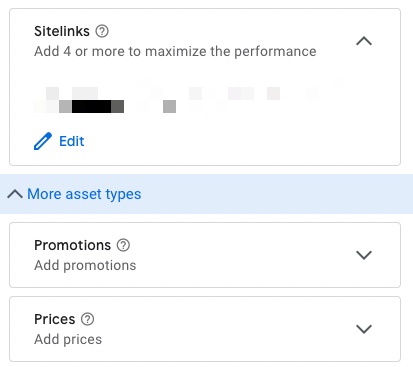Google announced in September two changes to ad extensions. First, it now calls “extensions” “assets.” Second, advertisers can create and edit assets in the same tab as Responsive Search Ads.
Extensions are additions to the ad standard unit. For example, this ad from Mountain Warehouse, a U.K.-based retailer, uses callouts, structured snippets, seller ratings, and location extensions.

Mountain Warehouse’s snow pants ad includes extensions: callouts, structured snippets, seller ratings, and location.
Before the September change, advertisers created ads and extensions separately in the admin. Advertisers can now create both in the same tab to see all possible combinations of the total unit. The move signifies Google’s view that assets are a key component — the more, the better.
Here is a sample admin interface for creating an ad with optional assets: sitelinks, promotions, and prices.

Advertisers can now insert “assets” — such as sitelinks, promotions, and prices — while creating Responsive Search Ads.
The revised interface includes new reporting in two sections. The first is the “Asset” view, which displays Google’s assessment of all your assets in headlines and description lines. That assessment, called “performance rating,” consists of five classifications: “Best,” “Good,” “Low,” “Learning,” and “Unrated.” Google does not share how it calculates these ratings and provides only the number of impressions per asset.
The second view is “Association.” Here you can observe the performance of other assets — such as sitelinks, callouts, and more — with traffic metrics at the account, campaign, and ad group levels. For example, you may see that ads using sitelink A have a better conversion rate than ads using sitelink B.
The new interface also updates the combinations report, which shows the number of impressions for all mixes of RSA ads and assets. This report does not include conversion data for each combination, but it does offer a sense of which ones Google favors and how they appear on search result pages.
Pointers
- The changes streamline ad creation. They do not impact ad strategy.
- Always deploy all 15 headlines and all four description lines. And use as many assets as relevant. Sitelinks, callouts, structured snippets, and images are now more or less standard for all accounts. Use other assets, such as price and promotion, when applicable. Ads are no longer just headlines and descriptions.
- Consider replacing assets ranked as “Poor,” although keep a Poor RSA running if it’s converting well. (Remember, we must play by Google’s rules of machine learning and automation while balancing our own performance needs.)
Transparency?
Google has not addressed how the updates impact Ads Editor. For many campaigns, Editor is more efficient at copying and pasting ads and assets. Google will likely change Editor’s interface, but there’s no timeline that I’ve seen.
Advertisers have long requested that Google provide more transparency around performance metrics. These latest updates are helpful, but they only scratch the surface. Ideally, we could view the conversion metrics for every asset and combination.
But Google presumably fears advertisers would pause everything that isn’t working, resulting in less data for its algorithm. I appreciate Google’s concern and understand the value of machine learning. Still, I’m hoping for a better balance.




